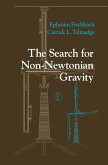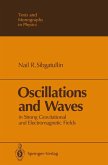112,95 €
112,95 €
inkl. MwSt.
Sofort per Download lieferbar

56 °P sammeln
112,95 €
Als Download kaufen

112,95 €
inkl. MwSt.
Sofort per Download lieferbar

56 °P sammeln
Jetzt verschenken
Alle Infos zum eBook verschenken
112,95 €
inkl. MwSt.
Sofort per Download lieferbar
Alle Infos zum eBook verschenken

56 °P sammeln
- Format: PDF
- Merkliste
- Auf die Merkliste
- Bewerten Bewerten
- Teilen
- Produkt teilen
- Produkterinnerung
- Produkterinnerung

Bitte loggen Sie sich zunächst in Ihr Kundenkonto ein oder registrieren Sie sich bei
bücher.de, um das eBook-Abo tolino select nutzen zu können.
Hier können Sie sich einloggen
Hier können Sie sich einloggen
Sie sind bereits eingeloggt. Klicken Sie auf 2. tolino select Abo, um fortzufahren.

Bitte loggen Sie sich zunächst in Ihr Kundenkonto ein oder registrieren Sie sich bei bücher.de, um das eBook-Abo tolino select nutzen zu können.
This monograph describes comprehensively and in sufficient detail both the theory and observation of gravitational lensing, an effect that is of growing importance for astronomical observations and cosmological modelling. This book is the first monograph (outside the USSR) on this topic.
- Geräte: PC
- ohne Kopierschutz
- eBook Hilfe
- Größe: 52.75MB
Andere Kunden interessierten sich auch für
![Gravitational Lenses (eBook, PDF) Gravitational Lenses (eBook, PDF)]() P. SchneiderGravitational Lenses (eBook, PDF)72,95 €
P. SchneiderGravitational Lenses (eBook, PDF)72,95 €![Gravitational Lensing: Strong, Weak and Micro (eBook, PDF) Gravitational Lensing: Strong, Weak and Micro (eBook, PDF)]() Peter SchneiderGravitational Lensing: Strong, Weak and Micro (eBook, PDF)80,95 €
Peter SchneiderGravitational Lensing: Strong, Weak and Micro (eBook, PDF)80,95 €![The Search for Non-Newtonian Gravity (eBook, PDF) The Search for Non-Newtonian Gravity (eBook, PDF)]() Ephraim FischbachThe Search for Non-Newtonian Gravity (eBook, PDF)72,95 €
Ephraim FischbachThe Search for Non-Newtonian Gravity (eBook, PDF)72,95 €![Oscillations and Waves (eBook, PDF) Oscillations and Waves (eBook, PDF)]() Nail R. SibgatullinOscillations and Waves (eBook, PDF)40,95 €
Nail R. SibgatullinOscillations and Waves (eBook, PDF)40,95 €![Cosmology in Scalar-Tensor Gravity (eBook, PDF) Cosmology in Scalar-Tensor Gravity (eBook, PDF)]() Valerio FaraoniCosmology in Scalar-Tensor Gravity (eBook, PDF)112,95 €
Valerio FaraoniCosmology in Scalar-Tensor Gravity (eBook, PDF)112,95 €![General Relativity and John Archibald Wheeler (eBook, PDF) General Relativity and John Archibald Wheeler (eBook, PDF)]() General Relativity and John Archibald Wheeler (eBook, PDF)112,95 €
General Relativity and John Archibald Wheeler (eBook, PDF)112,95 €![QSO Hosts and Their Environments (eBook, PDF) QSO Hosts and Their Environments (eBook, PDF)]() QSO Hosts and Their Environments (eBook, PDF)72,95 €
QSO Hosts and Their Environments (eBook, PDF)72,95 €-
-
-
This monograph describes comprehensively and in sufficient detail both the theory and observation of gravitational lensing, an effect that is of growing importance for astronomical observations and cosmological modelling. This book is the first monograph (outside the USSR) on this topic.
Dieser Download kann aus rechtlichen Gründen nur mit Rechnungsadresse in A, B, BG, CY, CZ, D, DK, EW, E, FIN, F, GR, HR, H, IRL, I, LT, L, LR, M, NL, PL, P, R, S, SLO, SK ausgeliefert werden.
Produktdetails
- Produktdetails
- Verlag: Springer US
- Seitenzahl: 560
- Erscheinungstermin: 6. Dezember 2012
- Englisch
- ISBN-13: 9781461227564
- Artikelnr.: 44058393
- Verlag: Springer US
- Seitenzahl: 560
- Erscheinungstermin: 6. Dezember 2012
- Englisch
- ISBN-13: 9781461227564
- Artikelnr.: 44058393
- Herstellerkennzeichnung Die Herstellerinformationen sind derzeit nicht verfügbar.
1. Introduction.- 1.1 Historical remarks.- 1.2 Outline of the book.- 1.3 Remarks about notation.- 2. Basic facts and the observational situation.- 2.1 The Schwarzschild lens.- 2.2 The general lens.- 2.3 The magnification factor.- 2.4 Observing gravitational lens systems.- 2.5 Known gravitational lens systems.- 3. Optics in curved spacetime.- 3.1 The vacuum Maxwell equations.- 3.2 Locally approximately plane waves.- 3.3 Fermat's principle.- 3.4 Geometry of ray bundles.- 3.5 Distances based on light rays. Caustics.- 3.6 Luminosity, flux and intensity.- 4. Derivation of the lens equation.- 4.1 Einstein's gravitational field equation.- 4.2 Approximate metrics of isolated, slowly moving, non-compact matter distributions.- 4.3 Light deflection by quasistationary, isolated mass distributions.- 4.4 Summary of Friedmann-Lemaître cosmological models.- 4.5 Light propagation and redshift-distance relations in homogeneous and inhomogeneous model universes.- 4.6 The lens mapping in cosmology.- 4.7 Wave optics in lens theory.- 5. Properties of the lens mapping.- 5.1 Basic equations of the lens theory.- 5.2 Magnification and critical curves.- 5.3 Time delay and Fermat's principle.- 5.4 Two general theorems about gravitational lensing.- 5.5 The topography of time delay (Fermat) surfaces.- 6. Lensing near critical points.- 6.1 The lens mapping near ordinary images.- 6.2 Stable singularities of lens mappings.- 6.3 Stable singularities of one-parameter families of lens mappings; metamorphoses.- 6.4 Magnification of extended sources near folds.- 7. Wave optics in gravitational lensing.- 7.1 Preliminaries; magnification of ordinary images.- 7.2 Magnification near isolated caustic points.- 7.3 Magnification near fold catastrophes.- 8. Simple lens models.- 8.1 Axially symmetric lenses.-8.2 Lenses with perturbed symmetry (Quadrupole lenses).- 8.3 The two point-mass lens.- 8.4 Lenses with elliptical symmetry.- 8.5 Marginal lenses.- 8.6 Generic properties of "elliptical lenses".- 9. Multiple light deflection.- 9.1 The multiple lens-plane theory.- 9.2 Time delay and Fermat's principle.- 9.3 The generalized quadrupole lens.- 10. Numerical methods.- 10.1 Roots of one-dimensional equations.- 10.2 Images of extended sources.- 10.3 Interactive methods for model fitting.- 10.4 Grid search methods.- 10.5 Transport of images.- 10.6 Ray shooting.- 10.7 Constructing lens and source models from resolved images.- 11. Statistical gravitational lensing: General considerations.- 11.1 Cross-sections.- 11.2 The random star field.- 11.3 Probabilities in a clumpy universe.- 11.4 Light propagation in inhomogeneous universes.- 11.5 Maximum probabilities.- 12. Statistical gravitational lensing: Applications.- 12.1 Amplification bias and the luminosity function of QSOs.- 12.2 Statistics of multiply imaged sources.- 12.3 QSO-galaxy associations.- 12.4 Microlensing: Astrophysical discussion.- 12.5 The amplification bias: Detailed discussion.- 12.6 Distortion of images.- 12.7 Lensing of supernovae.- 12.8 Further applications of statistical lensing.- 13. Gravitational lenses as astrophysical tools.- 13.1 Estimation of model parameters.- 13.2 Arcs in clusters of galaxies.- 13.3 Additional applications.- 13.4 Miscellaneous topics.- References.- Index of Individual Objects.
1. Introduction.- 1.1 Historical remarks.- 1.2 Outline of the book.- 1.3 Remarks about notation.- 2. Basic facts and the observational situation.- 2.1 The Schwarzschild lens.- 2.2 The general lens.- 2.3 The magnification factor.- 2.4 Observing gravitational lens systems.- 2.5 Known gravitational lens systems.- 3. Optics in curved spacetime.- 3.1 The vacuum Maxwell equations.- 3.2 Locally approximately plane waves.- 3.3 Fermat's principle.- 3.4 Geometry of ray bundles.- 3.5 Distances based on light rays. Caustics.- 3.6 Luminosity, flux and intensity.- 4. Derivation of the lens equation.- 4.1 Einstein's gravitational field equation.- 4.2 Approximate metrics of isolated, slowly moving, non-compact matter distributions.- 4.3 Light deflection by quasistationary, isolated mass distributions.- 4.4 Summary of Friedmann-Lemaître cosmological models.- 4.5 Light propagation and redshift-distance relations in homogeneous and inhomogeneous model universes.- 4.6 The lens mapping in cosmology.- 4.7 Wave optics in lens theory.- 5. Properties of the lens mapping.- 5.1 Basic equations of the lens theory.- 5.2 Magnification and critical curves.- 5.3 Time delay and Fermat's principle.- 5.4 Two general theorems about gravitational lensing.- 5.5 The topography of time delay (Fermat) surfaces.- 6. Lensing near critical points.- 6.1 The lens mapping near ordinary images.- 6.2 Stable singularities of lens mappings.- 6.3 Stable singularities of one-parameter families of lens mappings; metamorphoses.- 6.4 Magnification of extended sources near folds.- 7. Wave optics in gravitational lensing.- 7.1 Preliminaries; magnification of ordinary images.- 7.2 Magnification near isolated caustic points.- 7.3 Magnification near fold catastrophes.- 8. Simple lens models.- 8.1 Axially symmetric lenses.-8.2 Lenses with perturbed symmetry (Quadrupole lenses).- 8.3 The two point-mass lens.- 8.4 Lenses with elliptical symmetry.- 8.5 Marginal lenses.- 8.6 Generic properties of "elliptical lenses".- 9. Multiple light deflection.- 9.1 The multiple lens-plane theory.- 9.2 Time delay and Fermat's principle.- 9.3 The generalized quadrupole lens.- 10. Numerical methods.- 10.1 Roots of one-dimensional equations.- 10.2 Images of extended sources.- 10.3 Interactive methods for model fitting.- 10.4 Grid search methods.- 10.5 Transport of images.- 10.6 Ray shooting.- 10.7 Constructing lens and source models from resolved images.- 11. Statistical gravitational lensing: General considerations.- 11.1 Cross-sections.- 11.2 The random star field.- 11.3 Probabilities in a clumpy universe.- 11.4 Light propagation in inhomogeneous universes.- 11.5 Maximum probabilities.- 12. Statistical gravitational lensing: Applications.- 12.1 Amplification bias and the luminosity function of QSOs.- 12.2 Statistics of multiply imaged sources.- 12.3 QSO-galaxy associations.- 12.4 Microlensing: Astrophysical discussion.- 12.5 The amplification bias: Detailed discussion.- 12.6 Distortion of images.- 12.7 Lensing of supernovae.- 12.8 Further applications of statistical lensing.- 13. Gravitational lenses as astrophysical tools.- 13.1 Estimation of model parameters.- 13.2 Arcs in clusters of galaxies.- 13.3 Additional applications.- 13.4 Miscellaneous topics.- References.- Index of Individual Objects.







